FGCU Senior Projects, Spring 2016 Exhibition
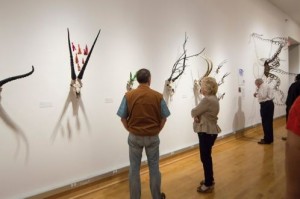 At the end of their studies, each art major is required to develop and present a coherent body of self-generated work that combines their knowledge of technique and concepts while drawing on research of historical and contemporary artists. Their work is presented to the faculty, student body and surrounding community in an exhibit that is staged at the end of their final semeeter. This exhibit, known as Senior Projects, Spring 2016, opens Thursday, April 14, with a reception from 5-7 p.m. Work by 19 graduating seniors is included in this show, which runs through April 29. The gallery is in the Arts Complex on FGCU’s main campus at 10501 FGCU Blvd. S. Parking is available in Lot 7 for gallery visitors. Regular viewing hours are 10 a.m. to 4 p.m. Monday through Friday, and 10 a.m. to 8 p.m. Thursday.
At the end of their studies, each art major is required to develop and present a coherent body of self-generated work that combines their knowledge of technique and concepts while drawing on research of historical and contemporary artists. Their work is presented to the faculty, student body and surrounding community in an exhibit that is staged at the end of their final semeeter. This exhibit, known as Senior Projects, Spring 2016, opens Thursday, April 14, with a reception from 5-7 p.m. Work by 19 graduating seniors is included in this show, which runs through April 29. The gallery is in the Arts Complex on FGCU’s main campus at 10501 FGCU Blvd. S. Parking is available in Lot 7 for gallery visitors. Regular viewing hours are 10 a.m. to 4 p.m. Monday through Friday, and 10 a.m. to 8 p.m. Thursday.
This page contains information about each of these future art professionals and their projects.
* * * * * * * * * * * * * * * * * * * * * * * * * * * * * * * * * * * * * * * * * *
FGCU art major Genie Clarke’s geometric musings seek to stimulate harmonious effect on viewers (04-19-16)
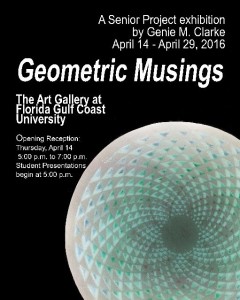 On view now in the Art Gallery at FGCU is the Senior Projects, Spring 2016 exhibition, which consists of the crowning achievements of 19 graduating art majors. Genie Clarke is included in this elite group, and her project is titled Geometric Musings, which fuses her love of art and meditation with the use of geometric patterns, light and color.
On view now in the Art Gallery at FGCU is the Senior Projects, Spring 2016 exhibition, which consists of the crowning achievements of 19 graduating art majors. Genie Clarke is included in this elite group, and her project is titled Geometric Musings, which fuses her love of art and meditation with the use of geometric patterns, light and color.
Clarke works in warm glass, which she colors using a simple fusing technique. Genie fuses crushed color glass, called “fritt,” to a single sheet of glass, which she enhances through the medium of light. “The powder fritt is sifted over a hand-cut geometric stencil that leaves a negative image in the 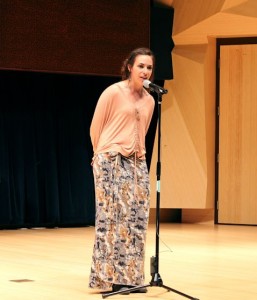 powder color field,” she explains in her Artist’s Statement. “The glass and fritt design then undergo a fusing and annealing process in a glass kiln. The glass is complemented with an additional layer of etched glass, which is sandblasted with the same stencil. The layers of glass are then accented with layers of cut, colored paper and plastic, and displayed in a mandala formed light box.
powder color field,” she explains in her Artist’s Statement. “The glass and fritt design then undergo a fusing and annealing process in a glass kiln. The glass is complemented with an additional layer of etched glass, which is sandblasted with the same stencil. The layers of glass are then accented with layers of cut, colored paper and plastic, and displayed in a mandala formed light box.
Genie credits contemporary glass artist Narcissus Quaggliata’s light painting techniques, James Turrell’s light studies, and Mark Rothko’s color field painting techniques as influences, and Eastern philosophies coupled with 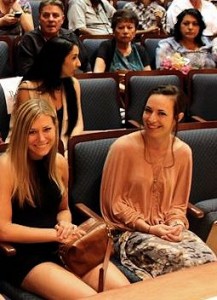 colorful geometric nonrepresentational designs found across many cultures as inspiration.
colorful geometric nonrepresentational designs found across many cultures as inspiration.
“My contemplative practices of yoga, meditation, music and art therapy are reflected in the process and end result of my work,” Genie points out. “These contemplative practices act as a release from the pressures of society providing me with improved balance between mind, body, emotions and spirit. Therefore, my work was carefully composed to support contemplative practices and stimulate a harmonious effect on its viewer.”
_____________________________________________________________________
Focus on ‘Voyage’ app created by FGCU graduating art major Maddie Chaffe (04-19-16)
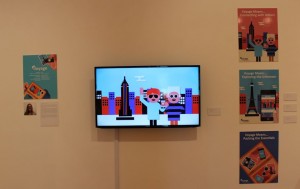 On view now in the Art Gallery at FGCU is the Senior Projects, Spring 2016 exhibition, which consists of work by 19 graduating art majors. Among this group is Maddie Chaffe, whose project consists of an app that connects travelers with locals while they are visiting a destination.
On view now in the Art Gallery at FGCU is the Senior Projects, Spring 2016 exhibition, which consists of work by 19 graduating art majors. Among this group is Maddie Chaffe, whose project consists of an app that connects travelers with locals while they are visiting a destination.
“The product matches its travelers based on age, 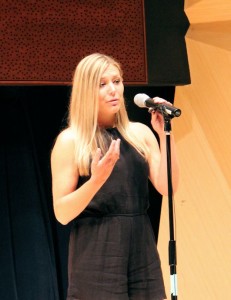 location and popularity,” writes Maddie in her Artist’s Statement. “When a traveler arrives at their destination, finding a new friend to explore with is now as simple as opening an application on their phone.”
location and popularity,” writes Maddie in her Artist’s Statement. “When a traveler arrives at their destination, finding a new friend to explore with is now as simple as opening an application on their phone.”
Users can also communicate with each other through the app, and find local attractions to visit based on their moods and preferences.
Chaffe created the prototype for the app using Adobe Illustrator and InDesign.
_________________________________________________________________________________
Focus on FGCU graduating art major and her vide0-based senior project ‘Self Judgements’ (04-18-16)
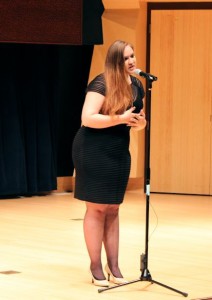 On view now through April 29 at the FGCU Art Gallery is an exhibition comprised of work by 19 graduating art seniors. Known as the Senior Projects, Spring 2016 exhibition, the show displays a wide range of thought-provoking work in a variety of media.
On view now through April 29 at the FGCU Art Gallery is an exhibition comprised of work by 19 graduating art seniors. Known as the Senior Projects, Spring 2016 exhibition, the show displays a wide range of thought-provoking work in a variety of media.
Titled Self Judgements, graduating senior Knoel Blake’s project examines and illustrates the ways women judge themselves based on quantitative numbers that represent to them their body type, their shape, their height, weight and bra or shoe size. “And so I challenge them in my project to look at more positive numbers in their lives,” Knoel said from the stage during her oral presentation last Thursday night. “To look instead at the things that shape them as women 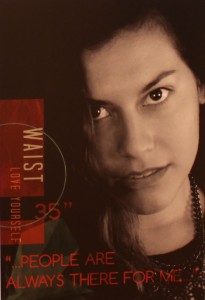 instead of the numbers that represent their appearance.”
instead of the numbers that represent their appearance.”
Currently, 80 percent of women in the U.S. are dissatisfied with their appearance. And more than 10 million are suffering from eating disorders.
“In modern times, we’ve witnessed a ‘thin at all costs’ movement that now defines Western culture,” writes Dr. Carolyn Coker Ross in World of Psychology. “The U.S. has the highest rates of obesity and eating disorders in the world. As a melting pot of people from all backgrounds, there is no genetic reason that explains this increased vulnerability to weight, body and food issues. Instead, we have to look at the messages our society sends about how we value our citizens.”
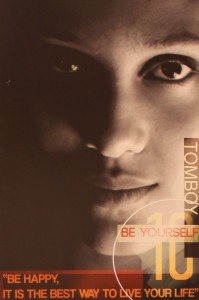 From a young age, women aspire to Barbie-like measurements that are physiologically impossible without surgery and/or starvation:
From a young age, women aspire to Barbie-like measurements that are physiologically impossible without surgery and/or starvation:
According to the National Eating Disorders Association, 42 percent of first- to third-grade girls want to lose weight, and 81 percent of 10-year-olds are afraid of being fat.
According to a study in Pediatrics, about two-thirds of girls in the 5th to 12th grades said that magazine images influence their vision of an ideal body, and about half of the girls said the images made them want to lose weight.
By adolescence, studies show that young people are receiving an 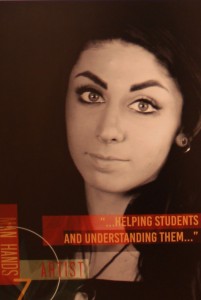 estimated 5,260 “attractiveness messages” per year from network television commercials alone.
estimated 5,260 “attractiveness messages” per year from network television commercials alone.
According to Teen magazine, 35 percent of girls ages 6 to 12 have been on at least one diet, and 50 to 70 percent of normal-weight girls think they are overweight.
“Over time, models have gone from thin to emaciated, which has been mirrored by a growing problem of eating disorders and body image dissatisfaction,” Dr. Ross continues. “In 1975, most models weighed 8 percent less than the average woman; today they weigh 23 percent less. Compared to the Playboy centerfolds and Miss America winners from 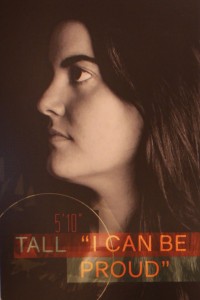 the 1950s, at least one-quarter of present-day icons meet the weight criteria for anorexia. Meanwhile, the average woman’s weight has increased. Whereas women used to look at role models who were average-sized, women are now comparing themselves with images (some of which are merely computerized conglomerations of body parts) that are unrealistically thin. In the old days, a young girl grew up wanting to look like her mother or best friend. Now she wants to look like Angelina Jolie. What most people still don’t realize is that the majority of the pictures they see in magazines are altered in some way and that looking like their role models is physically impossible. It is a setup for self-hatred.”
the 1950s, at least one-quarter of present-day icons meet the weight criteria for anorexia. Meanwhile, the average woman’s weight has increased. Whereas women used to look at role models who were average-sized, women are now comparing themselves with images (some of which are merely computerized conglomerations of body parts) that are unrealistically thin. In the old days, a young girl grew up wanting to look like her mother or best friend. Now she wants to look like Angelina Jolie. What most people still don’t realize is that the majority of the pictures they see in magazines are altered in some way and that looking like their role models is physically impossible. It is a setup for self-hatred.”
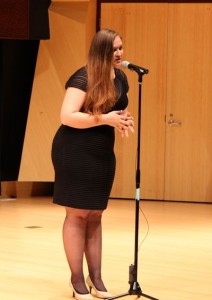 Blake herself confesses to suffering from body image issues that have largely gainsaid her numerous academic achievements and the many places she travelled during her academic career. “This seemed wrong, and this is where the project started,” Knoel states in her Artist’s Statement. “Finding myself so chained down, and depressed over numbers that do not determine who I am as a person, I decided to look at the positive numbers instead.”
Blake herself confesses to suffering from body image issues that have largely gainsaid her numerous academic achievements and the many places she travelled during her academic career. “This seemed wrong, and this is where the project started,” Knoel states in her Artist’s Statement. “Finding myself so chained down, and depressed over numbers that do not determine who I am as a person, I decided to look at the positive numbers instead.”
Toward that end, Knoel enlisted the help of some of her female friends, making videos in which they discuss the negatives by which they judge themselves before reflecting on the positives they all-too-often overlook. She then maps her videos onto three different panels. “There are posters accompanying the videos to help capture the emotion of the project in a few still snapshots.”
Judge for yourself. Please see above for gallery hours and parking information.
___________________________________________________________________
Through ‘Deconstruction,’ FGCU art senior Rachel Bass challenges viewers to challenge privilege of racial denial (04-18-16)
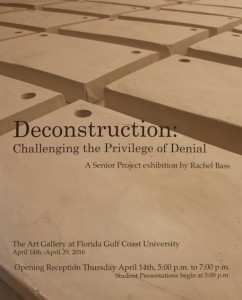 On view now through April 29 at the FGCU Art Gallery is an exhibition comprised of work by 19 graduating art seniors. Known as the Senior Projects, Spring 2016 exhibition, the show displays a wide range of thought-provoking work in a variety of media.
On view now through April 29 at the FGCU Art Gallery is an exhibition comprised of work by 19 graduating art seniors. Known as the Senior Projects, Spring 2016 exhibition, the show displays a wide range of thought-provoking work in a variety of media.
Graduating senior Rachel Bass calls her project Deconstruction: Challenging the Privilege of Denial. It consists of 151 plaster bricks that are inscribed with commonly used phases that people routinely employ to excuse or deny the pervasive existence of racism in the United States. There is one brick “for each year since slavery was abolished in our 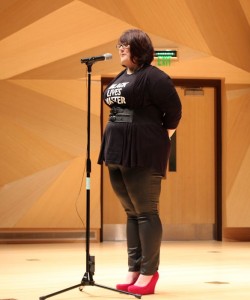 country,” Bass stated from the stage during the seniors’ oral presentations last Thursday night. “The repetition in the bricks alludes to the way we no longer question the validity of the statements because we hear and repeat them so often.”
country,” Bass stated from the stage during the seniors’ oral presentations last Thursday night. “The repetition in the bricks alludes to the way we no longer question the validity of the statements because we hear and repeat them so often.”
Sporting a “Black Lives Matter” tee, Rachel observes that white people have the privilege to ignore, deny and make excuses for problems we do not experience firsthand. “We do not see our own role in it. We do not own slaves, we no longer use the ‘N-word,’ and we even have black friends and family members. We would like to believe that we live in a world where color and race does not matter. However, the 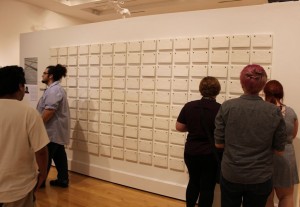 facts just don’t back that up,” Rachel states flatly, leaving no room for equivocation. So for her FGCU finale, Rachel created an interactive installation that encourages each of us to confront our own biases and blind spots in an enlightening, non-threatening way.
facts just don’t back that up,” Rachel states flatly, leaving no room for equivocation. So for her FGCU finale, Rachel created an interactive installation that encourages each of us to confront our own biases and blind spots in an enlightening, non-threatening way.
Her approach is simple and straightforward. Simply 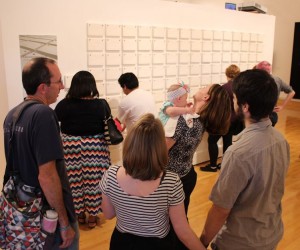 remove one of the 151 bricks and take it with you. “As the bricks are removed, statistics and facts on racism and its effects will be revealed on the gallery wall.” And the momento will remind you of what you’ve read and experienced.
remove one of the 151 bricks and take it with you. “As the bricks are removed, statistics and facts on racism and its effects will be revealed on the gallery wall.” And the momento will remind you of what you’ve read and experienced.
“It is my hope that through this deconstruction, conversations will be initiated among those of us who otherwise have the privilege to stay silent. If we love each other with the same amount of 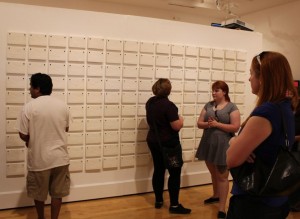 passion and fire that the very few among us use to hate other people, we can do better than what we’re doing.”
passion and fire that the very few among us use to hate other people, we can do better than what we’re doing.”
So? Do you have the courage to face your own biases and blindness?
Please refer above for gallery times and more information.
_____________________________________________________
‘Senior Projects Spring 2016’ exhibition opens at FGCU (04-17-16)
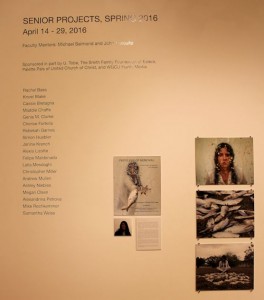 At the end of their studies, each art major is required to develop and present a coherent body of self-generated work that combines their knowledge of technique and concepts while drawing on research of historical and contemporary artists. Their work is presented to the faculty, student body and surrounding community in an exhibit that is staged at the end of their final semester. This exhibit, known as Senior Projects, Spring 2016, opened last Thursday (April 14), with a reception from 5-7 p.m.
At the end of their studies, each art major is required to develop and present a coherent body of self-generated work that combines their knowledge of technique and concepts while drawing on research of historical and contemporary artists. Their work is presented to the faculty, student body and surrounding community in an exhibit that is staged at the end of their final semester. This exhibit, known as Senior Projects, Spring 2016, opened last Thursday (April 14), with a reception from 5-7 p.m.
Work by 19 graduating seniors is included in this show, 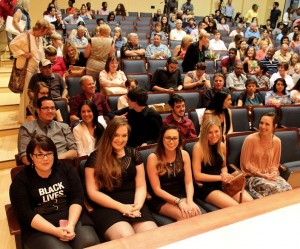 which runs through April 29. The exhibition is so large that art gallery was not able to hold all the work that’s on display, so three student projects are also on display in the library, two have been installed in the arts complex lobby and Faculty Choice Research Award recipient Leila Mesdaghi’s performance art piece is on view inside in a black pod parked outside the art gallery’s main entrance.
which runs through April 29. The exhibition is so large that art gallery was not able to hold all the work that’s on display, so three student projects are also on display in the library, two have been installed in the arts complex lobby and Faculty Choice Research Award recipient Leila Mesdaghi’s performance art piece is on view inside in a black pod parked outside the art gallery’s main entrance.
This semester’s graduating art majors and 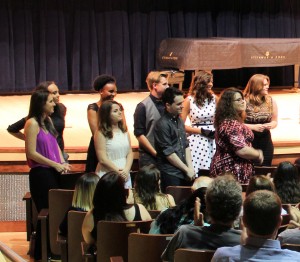 exhibiting artists are:
exhibiting artists are:
- Rachel Bass
- Knoel Blake
- Cassie Bretagna
- Maddie Chaffe
- Genie M. Clarke
- Cherise Fortella
- Rebekah Garnes
- Simon Huebler
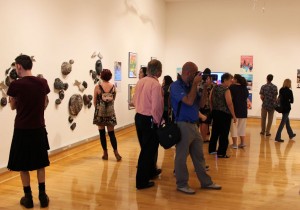 Janine Krench
Janine Krench- Alexis Lizotte
- Felipe Maldonado
- Leila Mesdaghi
- Christopher Miller
- Andrew Mullen
- Ashley Niebles
- Megan Olsen
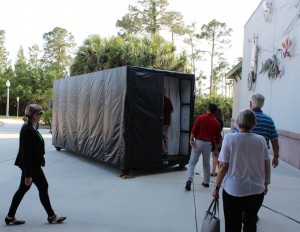 Alexandrina Petrova
Alexandrina Petrova- Mike Rechkemmer
- Samantha Weiss
Gallery Director John Loscuito and Professor Michael Salmond served as faculty mentors for the group.
The gallery is in the Arts Complex on FGCU’s main campus at 10501 FGCU Blvd. S. Parking is available in Lot 7 for gallery visitors. Regular viewing hours are 10 a.m. to 4 p.m. Monday through Friday, and 10 a.m. to 8 p.m. Thursday.
________________________________________________________________________
Focus on Cassie Bretagna’s ‘Remnants of Flesh and Bone’ sculptural installation (04-12-16)
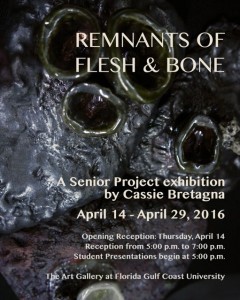 Senior Projects Spring 2016 opens in the Art Galleries at FGCU on Thursday, April 14. The exhibition includes work by 19 graduating art majors. One of those is Cassie Bretagna. In her senior project, Remnants of Flesh and Bone, she seeks to shine a light on the damage humans are perpetrating on the ocean’s coral reefs.
Senior Projects Spring 2016 opens in the Art Galleries at FGCU on Thursday, April 14. The exhibition includes work by 19 graduating art majors. One of those is Cassie Bretagna. In her senior project, Remnants of Flesh and Bone, she seeks to shine a light on the damage humans are perpetrating on the ocean’s coral reefs.
“My goal as an artist is to shed light on this serious matter and to make known that humans and nature are one,” writes Bretagna in her Artist’s Statement. “[W]hen we harm the ocean and coral reefs, we are consequently harming ourselves and the state of our planet as a whole. The ocean has been an 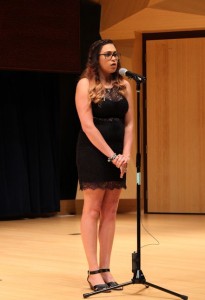 important place in my life since I can remember. It reminds me of all of the fun family vacations I had and the places I grew up around exploring. Many of my memories that I have with my family and friends took place while relaxing and enjoying all of the beaches wonders. The ocean and the coral reefs are dear to me and are worth protecting not only because their beauty and wonderful memories I have with it, but for the existence of our planet!”
important place in my life since I can remember. It reminds me of all of the fun family vacations I had and the places I grew up around exploring. Many of my memories that I have with my family and friends took place while relaxing and enjoying all of the beaches wonders. The ocean and the coral reefs are dear to me and are worth protecting not only because their beauty and wonderful memories I have with it, but for the existence of our planet!”
Cassie has chosen to convey this tragedy through the medium of clay. “Clay is a material that comes from the earth and shares some of the same chemical properties [as] coral.” And like coral, it is fragile as well. Her hand-built sculptures were cast using minimal carving tools 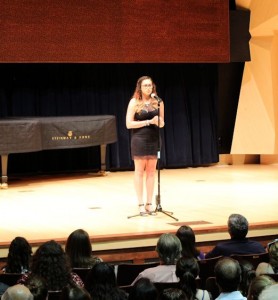 and two firing methods. “I used raku, which consists of taking the piece out of an 1800°F kiln and placing it into a dirt pit filled with combustibles. I also used saggar firing, which consists of hand-building a brick kiln and filling it with hay and wood, adding in salt, then copper oxide and iron oxide as coloring agents, and lighting it on fire. Both methods embrace taking beautiful, nature elements and throwing them into a fire, which I believe emulates what humans are doing to the environment.”
and two firing methods. “I used raku, which consists of taking the piece out of an 1800°F kiln and placing it into a dirt pit filled with combustibles. I also used saggar firing, which consists of hand-building a brick kiln and filling it with hay and wood, adding in salt, then copper oxide and iron oxide as coloring agents, and lighting it on fire. Both methods embrace taking beautiful, nature elements and throwing them into a fire, which I believe emulates what humans are doing to the environment.”
You can view Remnants of Flesh and Bone in the Art Gallery at FGCU beginning April 14. See above for more details.
_____________________________________________________________________
Focus on Leila Mesdaghi and performance art piece, ‘Privilege of Removal’ (04-12-16)
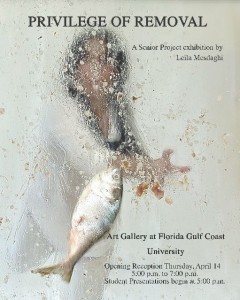 Senior Projects Spring 2016 opens in the Art Galleries at FGCU on Thursday, April 14. The exhibition includes work by 19 graduating art majors. One of those is Leila Mesdaghi.
Senior Projects Spring 2016 opens in the Art Galleries at FGCU on Thursday, April 14. The exhibition includes work by 19 graduating art majors. One of those is Leila Mesdaghi.
Leila’s project is titled Privilege of Removal. It challenges the ways in which we observe, react and respond to social and political issues. “Privilege of Removal is about our relationships and how we relate to the ‘others’ in the universal sphere; the ones we are not related to, the ones we cannot relate to, and the ones we do not give a damn about,” writes Mesdaghi in her Artist’s Statement. “We watch real life behaviors of physical, verbal, and moral abuse on T.V and 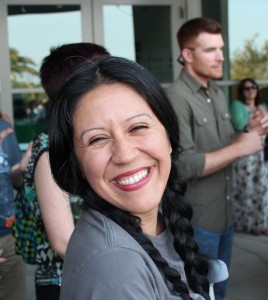 computer screens, and instead of rejecting we justify and accept them as socio-political norms. By literally throwing dead fish at a pane of glass, I act as a violent exhibitionist and also remind the viewer of our silent voyeuristic nature. I smash dead fish against the barrier that separates the world we live in from the world we witness.”
computer screens, and instead of rejecting we justify and accept them as socio-political norms. By literally throwing dead fish at a pane of glass, I act as a violent exhibitionist and also remind the viewer of our silent voyeuristic nature. I smash dead fish against the barrier that separates the world we live in from the world we witness.”
Leila chose for this performance piece a remote, private location that was once used as a residential facility for people with development disabilities. The fact that it had warehoused people rejected by their immediate families 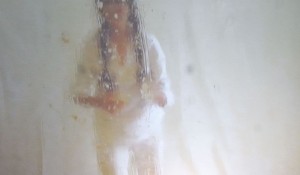 serves as a metaphor “of where moral and social responsibilities meet.”
serves as a metaphor “of where moral and social responsibilities meet.”
“Just because we have the privilege to look from distance and the privilege to remove ourselves, problems do not end and people do not stop suffering,” Leila points out. “Just because we send 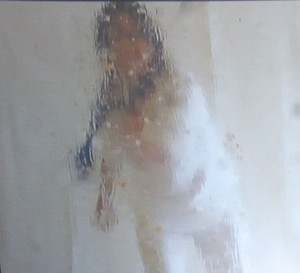 decorated cans of food to Africa and Haiti does not mean that we have compassion and are ending hunger, homelessness, and wars.”
decorated cans of food to Africa and Haiti does not mean that we have compassion and are ending hunger, homelessness, and wars.”
While Mesdaghi conceived of the project, she had help in its execution. Talented local photographer Mila Bridger photographed the performance, Artist Cesar Aguilera documented it, and Harold Elie helped with its installation. “In addition, I would like to thank John Loscuito, Dana Roes, and Barry Cavin, for their generous support in helping 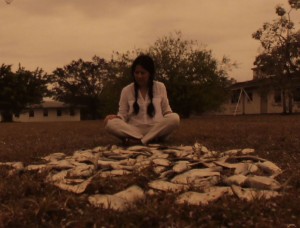 me develop and execute this exhibition,” Leila quickly adds.
me develop and execute this exhibition,” Leila quickly adds.
FGCU Art Gallery visitors may remember the two pieces that Mesdaghi had juried into last month’s 18th Annual Juried Student Art Exhibition. One was another 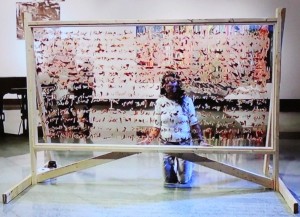 performance piece, called I’m Sorry for What I Said. Both powerful and evocative, the video depicted Mesdaghi licking words written in peanut butter off a piece of glass, leaving a residue of smears and smudges with her lips and tongue “There were words that came out of my mouth that I wanted to take back,” Leila explained. “I ate what I said, licked my words away and tried to heal the
performance piece, called I’m Sorry for What I Said. Both powerful and evocative, the video depicted Mesdaghi licking words written in peanut butter off a piece of glass, leaving a residue of smears and smudges with her lips and tongue “There were words that came out of my mouth that I wanted to take back,” Leila explained. “I ate what I said, licked my words away and tried to heal the 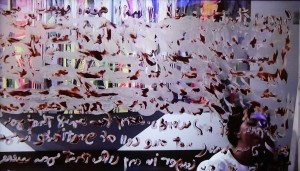 wounds. The residue is the memory of the pain, and that, I cannot take back.”
wounds. The residue is the memory of the pain, and that, I cannot take back.”
Performance is a genre of art that is typically presented live by the artist, either alone or in conjunction with performers, collaborators and sometimes even random viewers or spectators. It 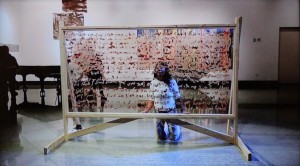 traces its origins back to Futurism and Dadaism and is characteristically employed to express discontent with conventional forms of art, such as painting and traditional modes of sculpture. But it can also be used to give voice to deeper psycho-social and political issues. Not surprisingly, a
traces its origins back to Futurism and Dadaism and is characteristically employed to express discontent with conventional forms of art, such as painting and traditional modes of sculpture. But it can also be used to give voice to deeper psycho-social and political issues. Not surprisingly, a 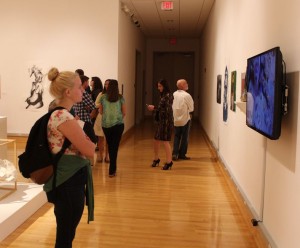 significant number of performance art pieces were conceived and presented in the 1960s, where they explored topics that ranged from the rise of feminism to anti-war activism.
significant number of performance art pieces were conceived and presented in the 1960s, where they explored topics that ranged from the rise of feminism to anti-war activism.
Although the concerns of performance artists have changed since the 1960s, the genre has remained a constant presence and has largely been welcomed into the conventional museums and galleries from which it was once excluded. In many instances, 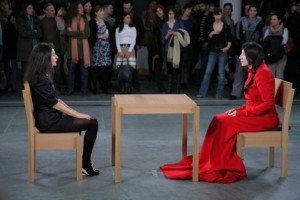 performance artists have deliberately included shocking components in an attempt to engage viewers both intellectually and emotionally in their work. In one recent exhibit at New York’s Museum of Modern Art, for example, one interactive performance piece left viewers tearful, shaken and inspired enough to permanently memorialize the experience through tattoos. Titled
performance artists have deliberately included shocking components in an attempt to engage viewers both intellectually and emotionally in their work. In one recent exhibit at New York’s Museum of Modern Art, for example, one interactive performance piece left viewers tearful, shaken and inspired enough to permanently memorialize the experience through tattoos. Titled 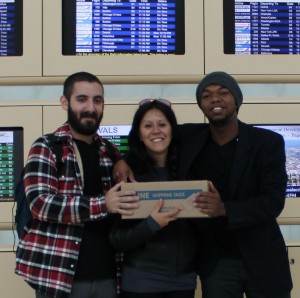 The Artist is Present, the exhibit featured artist Marina Abramovic seated in a chair staring intently across a small table at an empty chair. Members of the audience took turns occupying that chair as Abramovic peered through their eyes and seemingly into their very souls. Some laughed self-consciously. Many broke down in tears. Virtually all experienced some type of dramatic, raw emotion.
The Artist is Present, the exhibit featured artist Marina Abramovic seated in a chair staring intently across a small table at an empty chair. Members of the audience took turns occupying that chair as Abramovic peered through their eyes and seemingly into their very souls. Some laughed self-consciously. Many broke down in tears. Virtually all experienced some type of dramatic, raw emotion.
Mesdaghi often seeks to connect with viewers in the same visceral, evocative, emotional manner. To 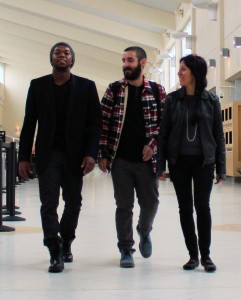 her, making art is a combination of emotional experience and social responsibility. She stands on uncomfortable ground and touches on social and political issues like war in the Middle East, the negative reflections of Social Media in society, the housing crisis in the U.S, or the price and promise of progress.
her, making art is a combination of emotional experience and social responsibility. She stands on uncomfortable ground and touches on social and political issues like war in the Middle East, the negative reflections of Social Media in society, the housing crisis in the U.S, or the price and promise of progress.
Leila was one of three Wish Ambassadors that Florida SouthWestern State College (then, Edison State College) sent to Reykjavik, Iceland in March of 2014 for purposes of delivering a box of wishes for world and personal peace that were collected by the Bob Rauschenberg Gallery during the 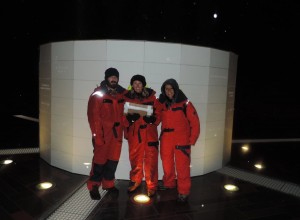 Yoko Ono Imagine Peace exhibition that opened there on January 24. (The others were Josue’ Charles and Christopher Lacoste.)
Yoko Ono Imagine Peace exhibition that opened there on January 24. (The others were Josue’ Charles and Christopher Lacoste.)
Leila had intended from the outset to lens a performance art piece during her stay in Iceland. She even brought along a chair that she’d used in a performance piece she staged at the Sidney & Berne Davis Art Center in 2013 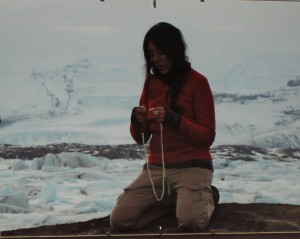 (referenced below). But when it came time for her to make the film, the absence of her son, her father and the others she’d left behind came rushing to the forefront. And as she mouthed their names while thumbing her prayer beads, giant tears cascaded down her cheeks and her nose began to run uncontrolled and unchecked, like the glaciers all around.
(referenced below). But when it came time for her to make the film, the absence of her son, her father and the others she’d left behind came rushing to the forefront. And as she mouthed their names while thumbing her prayer beads, giant tears cascaded down her cheeks and her nose began to run uncontrolled and unchecked, like the glaciers all around.
“The whole experience was just so overwhelming. 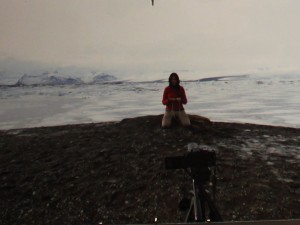 So overpowering. The landscape, the sea, was so expansive and uninterrupted. There we were on top of the world, so elevated that everything else seemed so small and inconsequential. I felt such a deep sense of gratitude that it made me want to cry. Professor Roes told me to just go with the emotion. To release it. And instead of having the camera take in my entire body as I’d originally intended, she focused the lens on just my face.”
So overpowering. The landscape, the sea, was so expansive and uninterrupted. There we were on top of the world, so elevated that everything else seemed so small and inconsequential. I felt such a deep sense of gratitude that it made me want to cry. Professor Roes told me to just go with the emotion. To release it. And instead of having the camera take in my entire body as I’d originally intended, she focused the lens on just my face.” 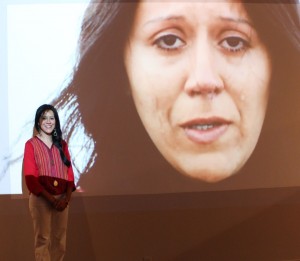 Roes’ well-hewn instincts were spot on. The close up footage of a crying, runny-nosed Mesdaghi took command of the Bob Rauschenberg Gallery during a follow-up to Yoko One Imagine Peace called ferdalag (which translates a journey or voyage; a creative process of self-discovery and overcoming)..
Roes’ well-hewn instincts were spot on. The close up footage of a crying, runny-nosed Mesdaghi took command of the Bob Rauschenberg Gallery during a follow-up to Yoko One Imagine Peace called ferdalag (which translates a journey or voyage; a creative process of self-discovery and overcoming)..
“The breakthrough for me was the creative power that comes from being in the moment,” Leila 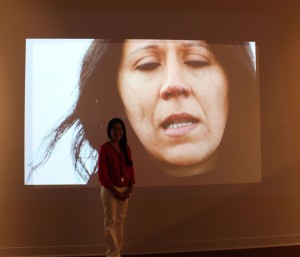 explained during the opening, unintentionally echoing the message of master entrepreneur, hip-hop mogul and New York Times bestselling author Russell Simmons, who advocates meditation as the fundamental key to living in the moment and releasing your untapped potential. As she worked her way around the length of her prayer beads, Leila never broke the immediacy of the performance, not even to wipe away a tear or the stream of mucous dripping over her lips in the
explained during the opening, unintentionally echoing the message of master entrepreneur, hip-hop mogul and New York Times bestselling author Russell Simmons, who advocates meditation as the fundamental key to living in the moment and releasing your untapped potential. As she worked her way around the length of her prayer beads, Leila never broke the immediacy of the performance, not even to wipe away a tear or the stream of mucous dripping over her lips in the 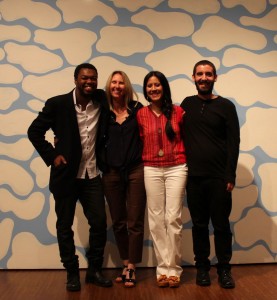 bitter Icelandic wind and cold.
bitter Icelandic wind and cold.
Many Southwest Florida residents and visitors vividly remember the piece titled Unspoken Words that Mesdaghi performed on the limestone steps of the Sidney & Berne Davis Art Center in 2013. “I believe that the root cause of violence and abuse is lack of selfless love,” says Leila of the piece. “ To increase the level of love in our blood and in the air, I decided to read love poems by Rumi. I invited the audience to choose a poem, write it, bring it to , and in return, I read each poem one hundred times.”
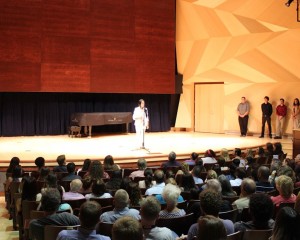 Mesdaghi hopes her work opens people’s eyes and helps change their attitudes about themselves, other countries and other people. “That’s what art is for. It goes beyond borders.” Of course, the themes she expounds through her performance and video pieces and paintings sometimes spark anti-foreigner sentiment. “They’ll say, ‘Well, if you don’t like it, why don’t you go back where you came from?’” But where Leila
Mesdaghi hopes her work opens people’s eyes and helps change their attitudes about themselves, other countries and other people. “That’s what art is for. It goes beyond borders.” Of course, the themes she expounds through her performance and video pieces and paintings sometimes spark anti-foreigner sentiment. “They’ll say, ‘Well, if you don’t like it, why don’t you go back where you came from?’” But where Leila 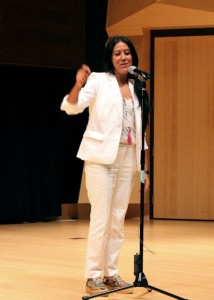 comes from is the United States. Although she was raised in Iran and educated there (she holds a Bachelors in Law from Tehran Azad University, Iran), she is American in birth right and temperament.
comes from is the United States. Although she was raised in Iran and educated there (she holds a Bachelors in Law from Tehran Azad University, Iran), she is American in birth right and temperament.
“Because I have an accent and because I have a diverse background, [they believe that] I don’t have the right to speak up,” Mesdaghi told the Fort Myers News-Press in a 2015 interview. But speak up she does. For example, Leila went out of her way to attend a recent meeting of the City of Fort Myers Public Art Committee that had been convened to decide whether a statue named Territorio (by internationally known Colombian artist Edguardo Carmona) 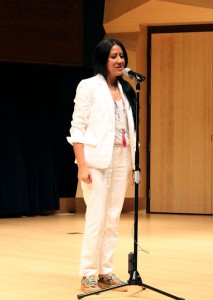 should be removed from the corner of Main and Hendry Streets in the downtown Fort Myers River District because it depicts a man and his dog urinating on a lamppost. “I don’t want to worry that I’m living in a small pond and that I need to leave here to be able to be a practicing artist,” Leila to the Committee. “Same as other little children when they pass by, when they look at something they want to be inspired that they can be creative and they should not censor themselves.”
should be removed from the corner of Main and Hendry Streets in the downtown Fort Myers River District because it depicts a man and his dog urinating on a lamppost. “I don’t want to worry that I’m living in a small pond and that I need to leave here to be able to be a practicing artist,” Leila to the Committee. “Same as other little children when they pass by, when they look at something they want to be inspired that they can be creative and they should not censor themselves.”
Leila will graduate from Florida Gulf Coast University with a Bachelors in Arts and minor in interdisciplinary studies. In addition to her performance pieces, Leila explores many other disciplines and media, from traditional painting to sculpture, printmaking, installations, and video art. But through them all, she continually seeks to prompt thought, introspection and discourse














 Tom Hall is both an amateur artist and aspiring novelist who writes art quest thrillers. He is in the final stages of completing his debut novel titled "Art Detective," a story that fictionalizes the discovery of the fabled billion-dollar Impressionist collection of Parisian art dealer Josse Bernheim-Jeune, thought by many to have perished during World War II when the collection's hiding place, Castle de Rastignac in southern France, was destroyed by the Wehrmacht in reprisal for attacks made by members of the Resistance operating in the area. A former tax attorney, Tom holds a bachelor's degree as well as both a juris doctorate and masters of laws in taxation from the University of Florida. Tom lives in Estero, Florida with his fiancee, Connie, and their four cats.
Tom Hall is both an amateur artist and aspiring novelist who writes art quest thrillers. He is in the final stages of completing his debut novel titled "Art Detective," a story that fictionalizes the discovery of the fabled billion-dollar Impressionist collection of Parisian art dealer Josse Bernheim-Jeune, thought by many to have perished during World War II when the collection's hiding place, Castle de Rastignac in southern France, was destroyed by the Wehrmacht in reprisal for attacks made by members of the Resistance operating in the area. A former tax attorney, Tom holds a bachelor's degree as well as both a juris doctorate and masters of laws in taxation from the University of Florida. Tom lives in Estero, Florida with his fiancee, Connie, and their four cats.